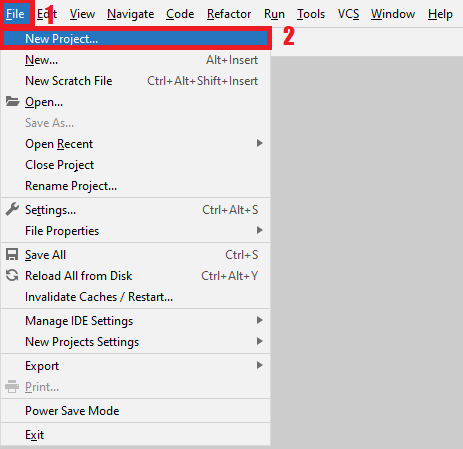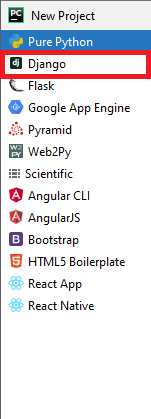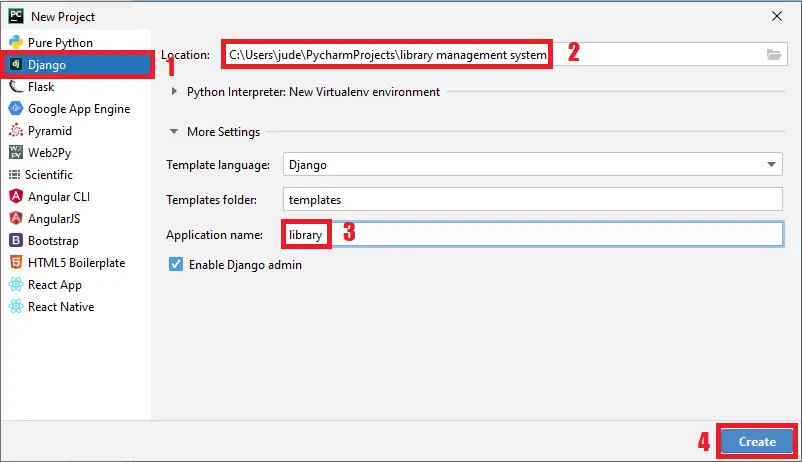A Library Management System in Django runs Django Framework in the back-end and HTML, and CSS in the front-end.
The project contains all the features of library management like login, interactive UI, issuing books to students, managing books, and adding books to the library.
This Django Library Management System also includes a downloadable Library Management System Project in Django Source Code for free download, just find the download library management system project in Python Django.
You can also read our other programming language used in the library management system
- Online Library Management System in PHP Source Code
- Library Management System Project In Python with Source Code
- Library Management System Project In C++ With Source Code
To start creating a Library Management System Project in Django, make sure that you have PyCharm Professional IDE Installed on your computer.
Project Information
| About Project | Project Details | Definition |
|---|---|---|
| Project Name | Library Management System Project in Django | The Library Management System Project in Django is developed using Python Django, HTML, CSS, and JavaScript. The Library Management System Using Django is an advanced management system that provides the interface. |
| Python version (Recommended) | 3.8 Version | Python 3.8 adds new syntax, modifies old behavior, and improves performance, following 3.7. |
| Programming Language Used | Python Django Language | Django is a Python web framework for building fast, safe websites. Django does much of the heavy lifting so you can focus on app development. |
| Developer Name | itsourcecode.com | Free projects containing source code in Java, PHP, Python, Django, VB.net, Visual Basic, C, C++, C#, JavaScript, and other languages are available on this website. |
| IDE Tool (Recommended) | Sublime, Visual Studio, PyCharm | Sublime Text is a source code editor that is available for purchase. It comes with built-in support for a variety of programming and markup languages. Plugins, which are often community-built and maintained under free software licenses, allow users to extend the functionality of the system. Sublime Text has a Python API to help with plugins. |
| Project Type | Web Application | A web application, unlike computer-based software programs that operate locally on the device’s operating system, is application software that runs on a web server. The user uses a web browser with an active network connection to access web apps. |
| Database | SQLite | SQLite is a programming language that is used to create embedded software for devices such as televisions, cell phones, and cameras. It can handle HTTP requests with low to medium traffic. SQLite has the ability to compress files into smaller bundles with less metadata. SQLite is a temporary dataset that is used within an application to process data. |
Reminders
To perform this python Django project, make sure that you have knowledge of the following:
- CSS
- HTML
- JavaScript
- Database Management
Django library management system
is an ERP system that a library uses to keep track of the materials it has, the orders it makes, the money it spends on bills, and the people who borrow from it.
Admin Features
- Manage Books – In this feature, the user can manage all the information of the books including, “add new book”, “update or modify book” and “delete book “.
- Manage Users – In this feature, the admin can manage all the information of users including, “add new user”, “update or modify user” and “delete user “.
- Manage Students – In this feature, the user can manage the list of students.
- Login/Logout System – With this feature, the user can log in and log out of the system.
Method Used
- library management – This method is the main method of the system project.
- management – In this method which is the management of the library system.
- media – In this method, you can find the uploading media like “photos” or other media files.
- template – This method is for the template design of the system including, “HTML,“ “CSS,” etc.
How to create a library management system project in Django
Time needed: 5 minutes
Here are the steps on how to create a Library Management System in Django
- Step 1: Open file.
First , open “PyCharm professional” after that click “file” and click “new project” .

- Step 2: Choose Django.
Second, after clicking “new project” , choose “Django” and click.

- Step 3: Select the file location.
Third, select a file location wherever you want.

- Step 4: Create an application name.
Fourth, name your application.

- Step 5: Click Create.
Fifth, finish creating the project by clicking the “create” button.

- Step 6: Start of coding.
You are free to copy the following codes below in the given modules and method required.
Downloadable Source Code Below
Anyway, if you want to level up your programming knowledge, especially Python, try this new article I’ve made for you Best Python Projects with source code for Beginners.
But if you’re going to focus on web development using Django, you can download here from our list of Best Django Projects with source code based on real-world projects.
How To Run the Library Management System Project in Django?
Step 1: Extract/unzip the file
Step 2: Go inside the project folder, open the command prompt, and type the following commands to install the Django web Framework and run the web server:
1.) python manage.py runserver
Step 3: Finally, open the browser and go to localhost:8000

Summary
The system is built fully in Django Framework in back-end and HTML, CSS in front-end, pip install, and HTTP 127.0.0.1 or 8000. It has a fully-featured user interface with all the functionalities.
This article helps us improve our skills and reasoning for programming in Python, a widely used language in many companies.
Inquiries
If you have any questions or suggestions about the Library Management System Project in Django, please feel free to leave a comment below.





it says ‘ModuleNotFoundError: No module named ‘crispy_forms”
while running the server
Install crispy-forms in virtual env by command prompt:
pip install django-crispy-forms